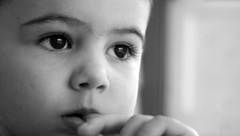
Two reports on poverty in Canada were issued in November, each with strikingly different conclusions. One said less than six per cent of Canadian children live in poverty; the other said the poverty rate for Canadian children was more than three times that, over 17 per cent.
How can that be?
Well, one report was from the Fraser Institute, a Vancouver-based think tank that primarily proposes competitive market solutions to social problems. The other was from Campaign 2000, a national coalition of community organizations that is promoting an end to child poverty -- echoing an all-party resolution in 1989 to accomplish that goal by the year 2000.
In issuing its number, the Fraser Institute celebrated the national poverty rate falling to the "lowest level in history," just under five per cent. It called the number of children living in poverty, just under six per cent, a "dramatic improvement." Not only were these numbers "historically" low, they also were much lower than rates of recent years.
Campaign 2000 reported that child and family poverty rates have been "entrenched" at around 17-18 per cent for the last five years. And that the rate has never been below 15 per cent since 1989, the year the House of Commons resolved to end child poverty.
Says who?
As you have probably guessed by now, the Fraser Institute and Campaign 2000 define poverty very differently, and this leads to very contrasting interpretations of what it is to live in poverty in Canada. There is no official definition of poverty in Canada, due no doubt to the fact that the calculation of how many people live below the poverty level is contentious. But how different are their definitions?
The measure used by Chris Sarlo of the Fraser Institute is a basic, bare-bones approach. Sarlo includes the cost of only what he considers the basic necessities for living. The cost of subsistence levels of food, clothing, housing, and a few other miscellaneous items are all that are included. For a family of four, this approach gives a figure of just under $23,000 as the poverty line.
Campaign 2000 relies on Statistics Canada to provide the yardstick. Stats Can does not measure poverty. Instead it issues "low income cut-offs," levels below which families would find themselves living in "straitened circumstances" because they would have to spend a greater portion of their income on basics such as food, clothing and shelter than does the average family of a similar size. Stats Can sets this line, for a family of four, at around $32,000.
For comparison, Stat Can reported that the median level of income for households of two or more people was $54,000 in 2004. For two-parent families with children, the median income level was nearly $72,000.
Generous deprivation
Neither the Fraser Institute nor Campaign 2000 can claim to have the "right" definition of poverty -- choices about what level of income constitutes a poverty line is a representation of values, goals and objectives. The Fraser Institute's rationale for its approach is that the Statistics Canada lines are too generous; they don't measure "true deprivation," thereby misrepresenting the number of people in Canada that can truly be labelled poor or impoverished. Sarlo defends his basic approach by asserting that his income lines measure not being able to afford the basic necessities of life.
Whatever the measure, there are too many poor people in Canada. By the measure of the Fraser Institute, we have more than 1.6 million Canadians -- hundreds of thousands of whom are children -- living in serious deprivation, conditions which are hazardous for health and development. One in every 18 Canadian children is living in deep poverty in a country that finds itself so rich it can afford to put down over 13 billion dollars as payment on the national debt.
Deep poverty is deprivation on an ongoing basis. It is not missing out for a month when funds are short. It is about not having money to participate in our society, period. And who is deprived in our country? In particular, people of colour and First Nations families. How else can we explain the overwhelming evidence that both First Nations and immigrants are disproportionately poor except by systemic discrimination?
Canadian underclasses?
But reserves are not the only holding places for the poor. Steep housing costs in the major urban centres of Canada are a big reason we have an ongoing class of poor children in our country. Here in Canada, we prefer not to look in the face of poverty nor admit that we have conditions that rival the Third World on our reserves and in our cities and towns.
While we pay down the national debt, we are running up a poverty debt that will sink the next generation. Rather than worrying about the next generation's fiscal debt load, we should be worrying that there will be a next generation that can work and participate as Canadian citizens. Living in poverty reduces both expectations for health and getting a job.
The poverty debt can be directly addressed through Canada's National Child Benefit. Raising the amount of the benefit for families with children provides immediate relief and lifts children out of deep and destructive poverty. Their parents also need help to be included in an economy that has been shedding unskilled workers. Parents need jobs that will support families. CPRN's study Too Many Left Behind found that nine million workers had not attained literacy levels that are expected of a productive worker. Canada needs to raise the skill level of our workers to be competitive in the new knowledge economy.
Forget about the ongoing debate about the measurement of poverty. That isn't the problem. The big problem is that we have too many poor children -- by any measure. ![]()














Tyee Commenting Guidelines
Comments that violate guidelines risk being deleted, and violations may result in a temporary or permanent user ban. Maintain the spirit of good conversation to stay in the discussion.
*Please note The Tyee is not a forum for spreading misinformation about COVID-19, denying its existence or minimizing its risk to public health.
Do:
Do not: